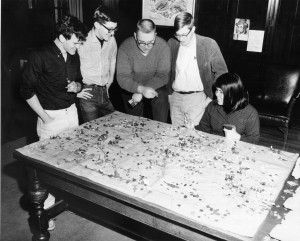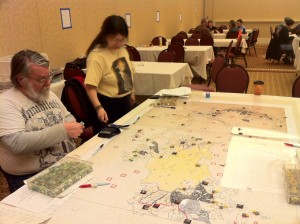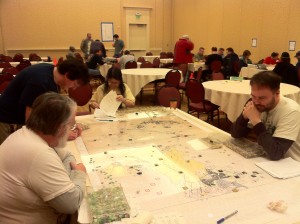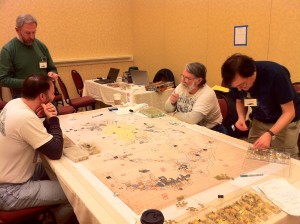Empire has a long history, including an early version developed in 1938 developed by a group of college friends from the University of California at Berkeley, which formed the basis for further development in the early 1960s by the son of one of the original inventors with his friends at Reed College, in Portland, Oregon. It then underwent ongoing development at Reed into the 1970s, but was played only occasionally after the mid-80s.
The original “Empire” game in 1938 was created by a group of buddies who had gone to college together at UC Berkeley, and then formed a sort of study group several years later. The group included Stillman Drake (graduated Berkeley in 1932), Mark Wrede Eudey, Dan Belmont and Henry “Bip” Ralston. Eudey reportedly wrote up those rules, but the full rules have apparently been lost (Eudey died in 2009, and his daughter Lynn reports that she has found nothing that old in his remaining papers).
Dan Drake tells us:
Yes, they were all in the Bay Area, working at whatever there was to work at in the 30s. Oddly, in those dismal times, finance seems to have been a bit of a growth industry for very bright young men. Eudey, a mathematician, got into some financial analyst work and discovered that there were no good sources for financial information on local governments in California, making it hard to prepare the offering documents that might convince Eastern bankers that there really was such a place with economic activity that could eventually pay off bonds. (I recall from 1960, when I did a summer stint at a muni banking house, stories of the ongoing difficulties of the East Coast in believing that California was good for its obligations due to huge growth) So he started his own little company to compile such data for sale to the business, and my father took a job there, which is how he got into the finance biz. I believe Belmont was in some financial work for a long time. Ralston wound up in what’s now called biomedical research.
So they were all conveniently placed to go to weekly meetings at somebody’s house. And if one was on the wrong side of the Bay, one could always get there on the commuter light rail system that occupied half the lower deck of the Bridge.

1963 Empire game in progress with (L to R) Peter Clark, Jim Trosper, Ron Hanks, J.D. Eveland and Lynne O’Connor. Image courtesy Reed College archives.
Empire was revived and metamorphosed at Reed College in the fall of 1960, with main game development by Dan Drake (graduated 1964), J.D. Eveland (also 1964), Alan Arey and Jim Trosper. Eveland had brought with him to Reed a copy of the then-new game Diplomacy, and talked several people into playing it at his dorm. Dan Drake and Jim Borders (1963) happened to wander by. Dan mentioned that “his father [Stillman Drake] had played a game on a map something like that that they called Empire back in the 1930s. He told us a little bit about this and we thought this sounded interesting enough that it might be worth experimenting with,” recalls Eveland. “So we agreed that I think it was the following weekend or something we would sort of try to tackle a version of this, recognizing that we were going to sort of make up the rules as we went along. And Dan remembered some things about this that his father had told him and we made up some others.”
Dan’s recollection is similar, but includes his father’s written summary (which survives today) of the 1938 rules:
So, in ’59–60, my freshman year, I encountered Avalon Hill games, or rather Tactics II, which I think was the only one available. That summer I got a copy. (Try to imagine a time when one could go downtown to the city’s big department store and go to its books department, which also carried games, and pick up the latest (or only) Avalon Hill game, and that in a time when there was no international cult of war gamers, and this thing was pretty obscure. For $5, by the way, IIRC, but it was worth all that money.)
One evening, my father was visiting, and he saw a Risk position spread out on the card table, and remarked that it reminded him of Empire. Of what? So he described the game that he and his friends had invented in the 1930s sometime. A bit of an anti-military game, in which armies were expensive and slow and clumsy and completely destructive. A few days after that, he typed up the rules from memory.…
So, when I got back for fall semester 1960, I was looking for Risk players or whatever, to try to set up an Empire game. Walking past Chittick one evening, I saw some people huddled around something that turned out to be Diplomacy (which I’d never heard of). That was my introduction to JD, Al Wood, and I forget who else.
So, we put these rules to use one Sunday afternoon, and played a few games, a few hours each, over a number of weeks, and things sort of [grew].
There were not a lot of other strategy and wargames for grown-ups available at the time, but the students borrowed ideas from a number of other sources. The initial combat results table and much of the combat system was borrowed from Tactics II (making combat significantly less obliterative than the 1938 game, but still bloody enough that it was usually avoided), while the negotiations and lack of formal rules on diplomacy and agreements owed much to Diplomacy and Risk. A unique feature of the game, lost in some later versions, was that in addition to the national governments that were more-or-less synonymous with the players, there could be corporations with independent existence, and the players/governments could own stock in those corporations. This last concept was borrowed from a Monopoly variant invented by Eveland, known as “Corporation Monopoly.”
Also unique to Empire was the freewheeling nature of the game itself, and the fact that while combat was possible and detailed, it was neither necessary nor the focus of the game. Eveland comments:
I go out of my way to avoid being in competitive situations. I don’t like win/lose situations and I have a visceral aversion to that. And so I tend—when I tended to create games and to arrange games I tended to find games that didn’t lend themselves to winning and losing.
The nice thing about Empire was it would go on long enough that you couldn’t figure out who was winning or who’s lost (laughs) and I sort of always when I was thinking of ways to expand the game I was always thinking of ways to make it less likely that you could tell when anyone was winning or losing. Not that people didn’t go up or down or not that there weren’t plays that you scored off of other people, but that the game itself became an exercise in art rather than the outcome.
And it was the process of the game that—at the end of the term there was usually a debate of a couple hours as to who was in better position and who was going to do what, but seldom any— there was never any need to come to a particular consensus. And I think this is one of the things that I—at least this lasted as philosophy of the game as long as I was involved with it. I have no idea if that changed later on but I was able to impose in a sense I think my ethos of non-competition into this. It’s not non-competition precisely. It’s de-emphasis on winning if you will….
In a sense the game was about telling a story. It was about developing a much—well, everything’s about stories ultimately, but this was really a game in which the story was the important part. You developed your story and everybody would create their own country with its own identity. And part of the pleasure of the game was creating the back story for your countries and why they would be interesting and why they were doing the things that they were doing. And people spent a great deal of time trying to figure out appropriate back stories that would reinforce these. And again points were awarded for creativity if you will.
It became a very engaging kind of thing. It became certainly a major component of identity for myself and several other people for a couple of years and it was regarded by the greater campus as a phenomenon.
At first the game was only played synchronously, which is to say when everyone was present at once. But after a year and a half, they started having more extended games, in which the board would be left set up in the middle of the Winch (dorm/residence) social room, and they’d come back to play more. At this point it rapidly became an asynchronous game, in which people would individually come to play their turns one at a time. When somebody finished their turn, they would take the dragon turn marker figure and leave it on the mapboard on the country of the next player, to indicate it was their turn.
Reed College Empire players of the early 1960s included Jim Kahan (’64), Ron Hanks (’64), T. Nicolaus “Nick” Tideman (’65), Tony Wannier (’66?), Peter Clark (’67), Lynne O’Connor (’67), Emerson Mitchell and Heather Rohde. Because the Winch social room was a major center of campus activity, and highly visible (from a major campus walkway artery), during the year or two it was hosted there, the game itself became well known on campus. “it was impossible not to know we existed,” writes Emerson Mitchell. Indeed, that same prominence helped draw him in:
The first few times I saw Empire I was fascinated by the view thru the window into the end of the old dorm block as I walked to Elliot Hall from Foster/Schultz.
I observed it whenever I could, and hung around that dorm room whenever I could. Since the game itself lasts at least a semester, I had to wait and ask to get into a game as it started.
Empire even helped him meet his future wife, as he explains:
My wife learned my name watching us play in Foster/Scholz social hall. I had noticed her watching but when she said “Emerson, you are beautiful” I was striding down the hill with my cape and long hair blowing in the wind, I decided I had to get a date with this girl! I did, and by the next june we were reciting wedding vows. 40th anniversary is June 12! [2011—ed.]
Over the summer of 1962, while working a summer job at the University of Michigan, J.D. Eveland built a set of several thousand custom pieces for the game, cut from a soft wood, glued together, and painted in various player colors. The custom pieces included construction machines, planes, multiple ship types, and tanks. Eveland housed these in a similarly custom-built wooden shelf unit with small plastic drawers. Besides the custom pieces, the game made use of stock certificates borrowed from some other game, 1⁄72 scale plastic soldiers, small toy vehicles and other bits. The custom box and some of the pieces still survive in the Reed College archives, having recently been rescued from the basement of one of the dorms.
Not all the homemade pieces were successful. Mitchell says “One of the types was small cubes from a kind of eraser that tended to stick together and eventually dissolved the drawer they belonged in!”
Resource allocations on the first map were done based on real-world resources at the time. Interestingly, this gave a huge edge to players starting in North America. For the second game, players were prohibited from starting in North America proper, but this just became a race to take over North America instead. This led to the creation of the first game mapboard to use a map of an imaginary world.
The 1960 game mapboard used a simple square grid, like chess or Tactics II (or the 1938 version), but with more squares. This was replaced by a map using hexagons (“hexes”), but that was hard to draw. Further maps used rows of offset squares, equivalent to hexes but much easier to draw. This offset-squares approach, with 1″ squares and a 42″ x 72″ board, was in use by 1964 and remained the standard thereafter.
Even by the end of Drake and Eveland’s time at Reed in the summer of 1964, the rules had not yet been written up as a single coherent document, there were just the combat results table (borrowed from Tactics II) and a single page of revised economic rules they had come up with part-way through their time at Reed. “The rules were just sort of known,” says Jim Kahan, one of the original players. “It wasn’t written down, it wasn’t discussed. There was no arbitrator. There was no person. Any contentious decision had to be negotiated. If there was a battle, it had to be publicly witnessed because the tactics, the outcomes of battles were determined by the roll of [the] dice.”
Empire was actively developed through the 1960s and 1970s, and the rules were further formalized. Andrew Nisbet (’73) was the long-time head of the “Empire Association,” even after he was no longer a student, and organized the game for years. He played when he arrived at Reed in 1967, assembled the first real rulebook for the game almost from scratch in 1969, and went through several further rewrites and expansions of the written rules until his last completed version in 1976 (with minor additions thereafter).
[Note: This section needs a lot of work yet. Ideally coverage of the ’67–80s period could have the same richness as the early ’60s.]
My own (Thomas Phinney’s) reminiscences:
I never saw Empire being played while I was a student at Reed, in the fall of 1983, but somebody in the gaming club gave me a copy of Nisbet’s 1976 rules and record sheets. In particular I never saw a board, which would have given me guidance on some important considerations such as density and placement of resource spaces on the board.
Years later (1990−91) I retyped the rules and record sheets in Microsoft Word. I made minor changes to the game, mostly a few clarifications and adding a glossary of terms, as well as a more questionable introductory section. This version of the rules still exists in hard copy and as a reasonably “clean” digital version (an OCR’d scan to PDF). I also created one or two maps from scratch.
I played twice with friends in multi-month games. Even without knowing the game’s lore, philosophy and history, something about it, and perhaps us, promoted the story-telling aspect of the game. I still have several issues of the “national newspaper” I created for the country I was playing in one of our games.
I later restructured my variant of the rules, and started adding a few optional rules. Since getting in touch with original Empire players in 2011, and learning more about the game, I have embarked on further revision and tweaking, and am working on incorporating all the surviving rules change petitions, and bringing the rules back a bit closer to their origins.
Empire Artifacts
At one point the game maps, pieces and accessories were held at a Reed student house known as “The Consulate” (so named for its concentration of Empire players, we are told). After that house stopped being a center of Empire activism, Nisbet and friends rescued the Empire materials from the basement, and carried them, table and all, to the Foster-Scholz dormitory, where they remained for several years.
Over time, the usage of pieces versus records in Empire changed significantly. In the late 1960s, there were pieces for everything in Empire, including even some immobile things such as factories. Of course, a city held too many things to keep them all in one space on the board, so players used a set of egg cartons to contain the contents of all the cities. You could take them out as needed during the turn, and at the end of the turn you would dump all your city contents back into them.
Eventually records reduced the need for having quite so many pieces, and keeping so many on the board. City sheets tracked everything in a city at the end of the turn, and so did away with the egg cartons. Had-Used-Produced (HUP) sheets allowed you to track what you built. That being said, there were still pieces being used all the way up to the end of the classic Empire period (the mid-1980s), but by then players just pulled pieces out of a box, used them during their turn to figure out their moves, and then put them away after updating their record sheets at the end of the turn.
One of the limiting factors within the game was the availability of worker units (known as “coolies”) to move key resources from their production sites to factories and between factories. The intricate movements with workers moving things from one place to another and free workers coming back to replace them became known as “coolie shuffles.” Whether because of complexity or temptation to cheat (in the face of limited numbers/locations of workers), some players would end up doing shuffles that were not in fact possible within the rules. “Checking people’s coolie shuffles became a ritual pastime,” says Nisbet. If looking at another player’s records revealed a shuffle that seemed implausible, if you were not yourself a veteran player, doing such checking involved getting an experienced player to see if they could come up with a way to replicate the same change from starting position to an ending position for the turn. If not, a challenge might be made to the player’s records for them to demonstrate how they got from their starting point to their ending point for that turn.
Where are they now?

Andrew Nisbet surveys an Empire map and pieces being set up to play Tac 5 (March 2011 at the GameStorm convention in Vancouver, WA)
Currently, the surviving original maps (scans of most are available) are held less than a block from the Reed campus, at the home/office of McCullough Research, by Empire player and Reedie Robert McCullough. He, Nisbet and others occasionally use the Empire maps to play a game they call Tac 5, which is based on the combat portion of the Empire rules. They usually use reprinted versions of the 1970s maps rather than the originals, along with the 1970s pieces.
The tattered green binder is still held by Andrew Nisbet. What is left of the original 1960s pieces are held at the Reed College archives, in the basement of the library. The table from the Winch social room somehow got commandeered and stayed with the game, wherever it migrated, and is currently held by the Association of Reed Gamers (ARG), in the Old Dorm Block basement “dungeon.”
Beside and below are photos of Tac 5 being set up for a game at the GameStorm convention, in March 2011, in Vancouver, Washington (which is essentially a large suburb of Portland, Oregon).
Stillman Drake (1910−93) quit his successful career in finance in favor of a second career as a science historian (starting in 1967), and was best known as the world’s greatest expert on Galileo, who won numerous awards.
Mark Wrede Eudey (1912−2009) got a PhD in mathematics from UC Berkeley, and worked for Cal Municipal Statistics for many years. Serving with the US Air Force in World War 2, he took a special assignment that required someone who could both parachute and knew statistics: he was dropped behind enemy lines and did statistical analysis of the effectiveness of high altitude bombing in Germany (not as effective as the Allies had hoped). Eudey and Bip Ralson were avid chess players, who co-founded (with Guthrie McClain) the California Chess Reporter publication in the summer of 1951.
Henry James “Bip” Ralston was a research physiologist, whose “research on the physiology and the mechanics of human walking led to major improvements in artificial limbs for amputees.” He died at home in San Francisco in 1993.
J.D Eveland lives in Los Angeles, where he teaches business administration and information systems at TUI University.




What might you know about my dear friend Alan L Arey, former room mate, whom I have not seen in 40 years…
John, I’ve emailed you with contact info for Alan. 🙂